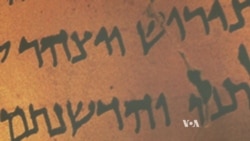The manuscripts known as the Dead Sea Scrolls were uncovered in the mid-20th century, and they are still yielding clues about life and religious beliefs in ancient Israel. An exhibit in Los Angeles shows how modern science is bringing the history of these ancient documents to life.
The largest exhibit of its kind ever shown outside Israel can be seen at the California Science Center. Visitors learn the story of the scrolls, ancient manuscripts that were hidden in caves in the modern-day West Bank during the first century, to safeguard them from advancing Roman troops during a Jewish rebellion.
The scrolls were written over hundreds of years and illustrate the diversity of ancient Israel, which was home to various Jewish sects, as well as early Christians.
Israel's Consul General in Los Angeles, David Siegel, whose office helped bring the exhibit to the city, says the documents include sectarian writings and Biblical texts that are important to three faiths.
“When that shepherd in 1947 entered that cave and found these parchments, what he discovered were the earliest known manuscripts of the Bible. So they're significant obviously to Jews, but they're also significant to Christians and they're significant to Muslims," said Siegel.
The California Science Center's Diane Perlov says scientists have studied the manuscripts using modern techniques - piecing together thousands of parchment and papyrus fragments into hundreds of documents. She says they used different kinds of light to decipher hidden texts, and tested the material for dating.
“Scientists used multi-spectral imaging, carbon 14 dating, DNA analysis and other tools to match up all these individual pieces to the same scroll, to read them," said Perlov.
Exhibit co-curator Risa Levitt Kohn says the dry climate of the region helped preserve the writings, leading to one of the most important archeological discoveries of recent times.
“The humidity, the temperature, the fact that these documents were hidden in caves," said Kohn.
Together with 20 Dead Sea Scrolls, on display in the exhibit, visitors can see royal and ritual objects and items from daily life that span 1,200 years. They include a small figure thought to be Asherah, the mother goddess once worshipped throughout the ancient Near East, as well as coins, pottery, and a three-ton stone from the Western Wall, the only remains of the second Jewish temple that was destroyed by invading Romans in the year 70. The objects show the diversity of cultures - Jewish, Greek and Roman - that sometimes led to tensions.
The ongoing analysis is the work of many experts, says exhibit co-curator Debora Ben-Ami of the Israeli Antiquities Authority.
“We are showing a complete story, coming from the present, going back to the past, to a different time, to a different place, and then understanding all the context and all the importance of this history," said Ben-Ami.
Ben-Ami says many questions are still unsettled, including the identity of the people who hid the scrolls. But scientists and scholars are still working to shed light on these ancient documents.






